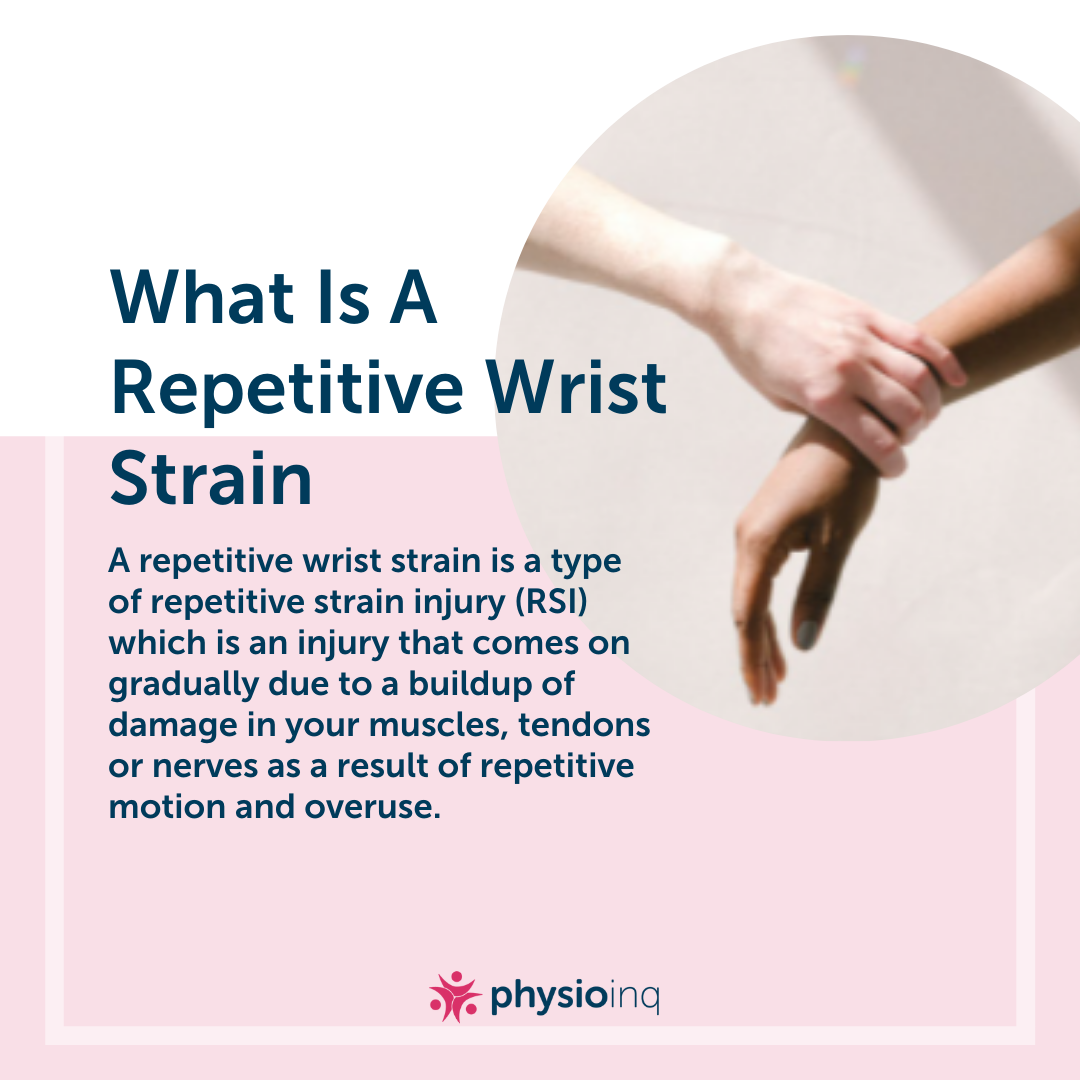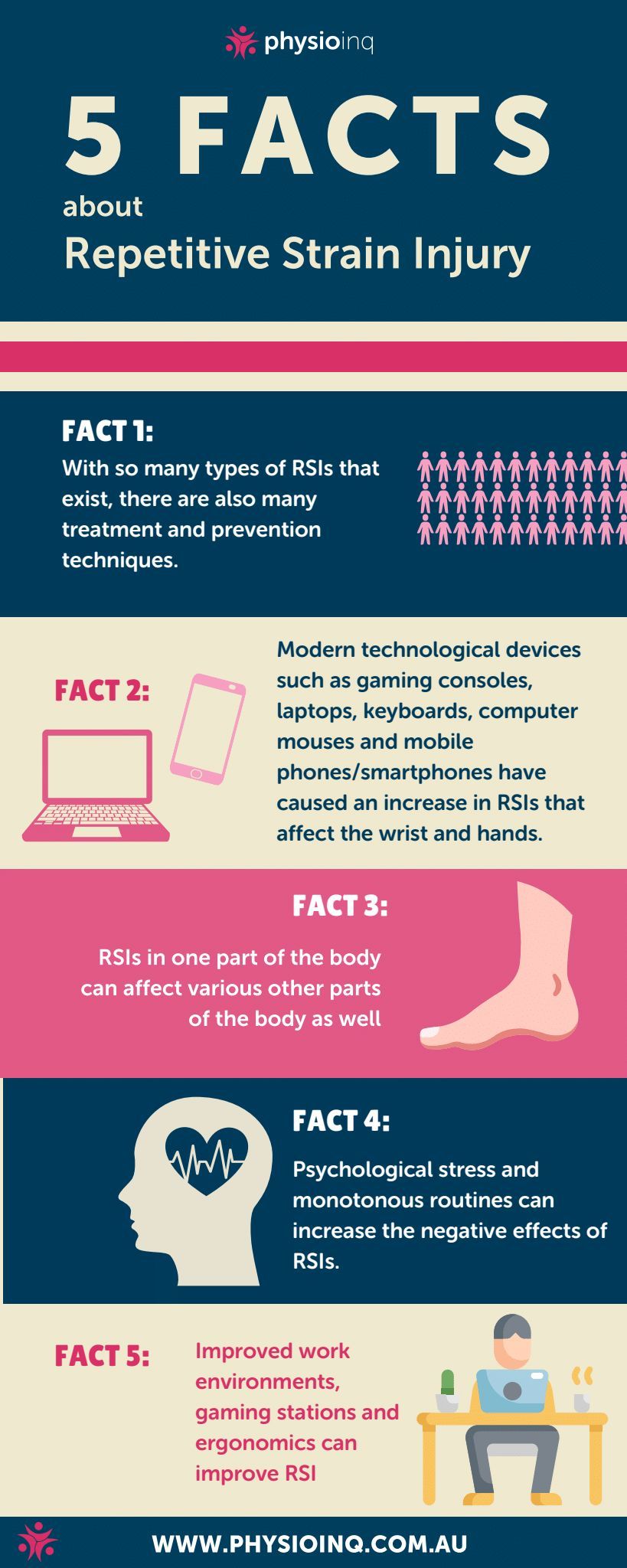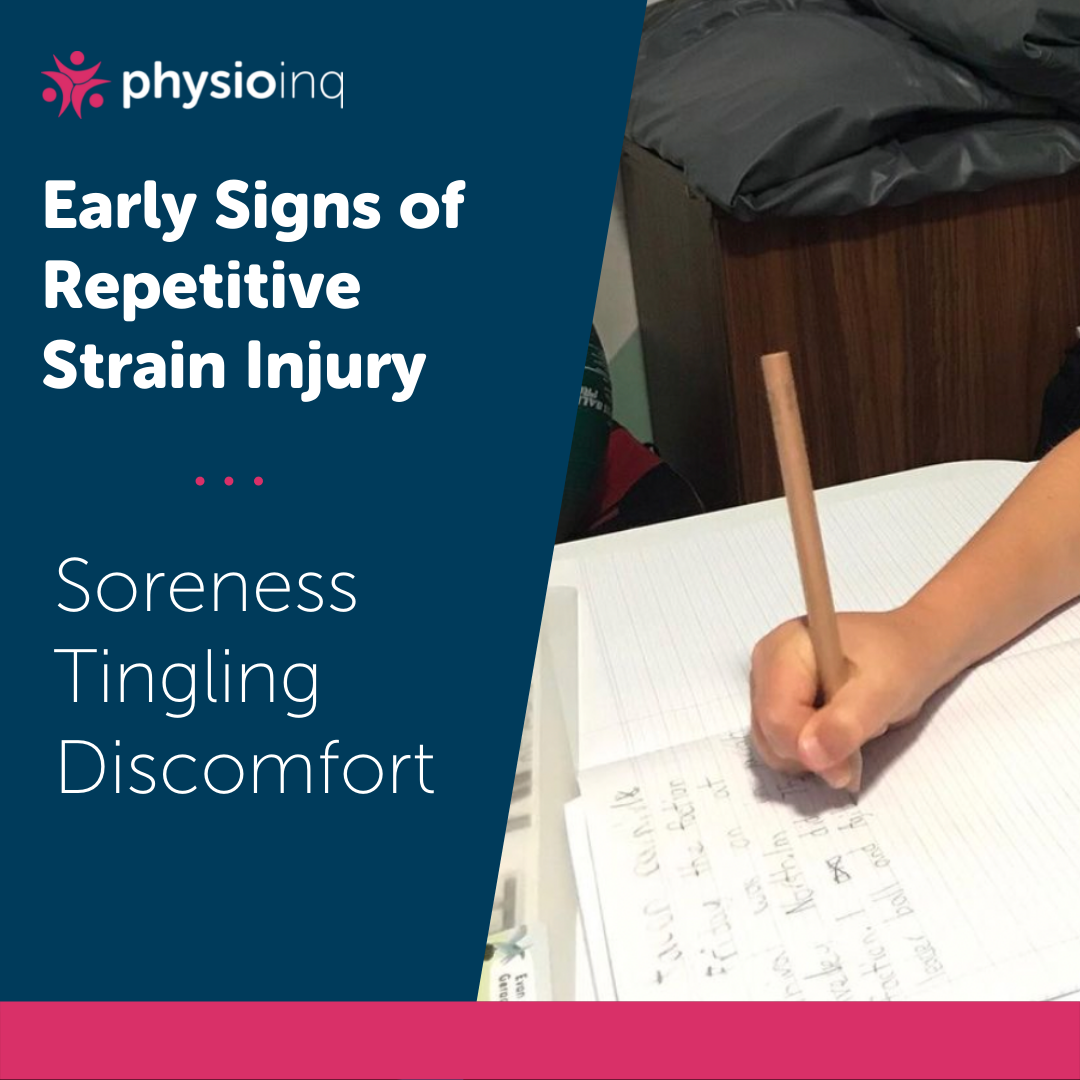Make an Appointment
Repetitive wrist strain injuries come in all shapes and sizes. These elusive conditions cover a wide range of various syndromes and conditions, many of which are specifically associated with the hands and wrists.
Often, people wait too long to start treating potential repetitive strain injuries. And with our modern workplace becoming more and more digital, those who work at desk jobs and spend their days typing away are even more at risk for developing repetitive wrist strain.
To treat and prevent these frustrating and painful injuries, it’s important to understand their cause and what to do when you begin to notice symptoms. Here, we’re going over everything you need to know about repetitive strain injuries in your wrist and how a physio can help.

What is a repetitive wrist strain?
A repetitive wrist strain is a type of repetitive strain injury (RSI) which is an injury that comes on gradually due to a buildup of damage in your muscles, tendons or nerves as a result of repetitive motion and overuse.
There are many types of RSI wrist injuries. Examples of some repetitive strain injuries that affect the wrist and hand include:
-Tendonitis: Inflammation of a tendon
-Tendonosis: Breakdown of the collagen within a tendon
-Carpal tunnel syndrome: Compression of the main nerve that runs through your wrist
-Raynaud’s disease: Constriction of blood vessels when cold or stressed, often triggered by vibration such as while using power tools
-De Quervain’s syndrome (Gamer’s thumb): Painful condition affected the tendon that runs on the thumb side of the wrist due to overuse
-Intersection syndrome: Inflammation of forearm muscles due to repetitive flexion and extension of the wrist
-Dupuytren’s contracture: When the tissues deep within your hand thicken and cause permanently bent fingers, often triggered by vibration
-Stenosing tenosynovitis (Trigger finger): When a finger becomes “stuck” in a bent position causing a click or snap when attempting to straighten it
-Writer’s cramp: Muscle spasm in the hand due to overuse
As you can see, there are various types of RSIs that affect the wrist and even more that can affect other muscles, tendons and nerves throughout your body.
Facts About Repetitive Strain Injury
Before we go into more detail about repetitive strain injury, let’s begin by going over some simple facts regarding the condition.

Early Signs of Repetitive Strain Injury
First, let’s go over some of the early signs of repetitive strain injuries. By noticing some of the signs that lead to full-blown RSIs, you have a better chance of preventing their more negative consequences later on.
Some of these early signs of RSIs include:

At the first sign of an RSI, your best option is to stop the aggravating activity and rest so that your body can readjust. Otherwise, you’ll risk creating a chronic injury that may never fully go away.
Repetitive Strain Injury Wrist Symptoms
The most common repetitive strain injury wrist symptoms include:
- Burning, aching or shooting pain ranging from mild to severe
- Tenderness
- Swelling
- Stiffness
- Tingling or numbness
- Throbbing or pulsing sensation
- Cramping
- Weakness, muscle fatigue or loss of strength
- Sensitivity to temperature
- Difficulty with everyday tasks requiring fine motor skills
While you might not experience all of these symptoms at the same time when you develop an RSI, it’s likely that you’ll have at least a few of these symptoms.
Even if you’re only experiencing a few mild symptoms, it’s important to rest immediately and often afterwards. If your symptoms get worse, it’s recommended to see your GP or a physiotherapist right away.

Causes and Risk Factors for Repetitive Strain Injury Wrist
As its name suggests, the main cause of repetitive strain injury of the wrist is repetitive motion. In other words, by moving your wrist in the same way day in and day out, you’re at risk of causing damage to your muscles, tendons and nerves in the process.
Some of the main causes and risk factors for repetitive wrist strain include:
- Stressing the same muscles due to repetition
- Keeping the same body posture for long periods of time
- Keeping an abnormal posture for extended periods
- Heavy lifting
- Poor physical fitness or lack of an exercise routine
- Previous injuries
- Many years working at a desk job
- Frequent gaming, typing, texting and scrolling on a smartphone
As you can see, apart from heavy lifting or previous injuries, most of the causes and risk factors for developing an RSI are modern afflictions.
More than any other generation, we are more sedentary and prone to abnormal or poor posture. We’re less active and therefore often in much poorer physical shape than our ancestors and we spend most of our waking hours typing and texting while sitting at a desk or on our lounges.
It’s why it’s more important than ever to understand the symptoms of RSI and to take the early warning signs seriously as your body can be permanently affected if the proper precautions are avoided.
What To Do If You Have Repetitive Wrist Strain
The tricky thing about repetitive strain injuries is that they come on gradually. So, it’s easy to avoid taking action until it’s too late.
If you suspect that you might have early signs of repetitive wrist strain or you’re experiencing symptoms of an RSI, be sure to consult with your GP who can refer you to a physiotherapist to begin treatment.
Additionally, if you suspect that your job duties may have caused an RSI, speak to your employer about their workplace safety protocols to ensure you’re going through the proper channels for treatment.
Workers who are often at risk of repetitive strain injuries of the wrist include:
- Dental hygienists
- Tradies who handle power tools
- Cleaners
- Cooks
- Bus and truck drivers
- Musicians
- Desk job workers
Again, many modern workers are most at-risk for RSIs. Especially RSIs that are concerned with the hand and wrist since typing, texting and other ways we use fine motor skills are constant and habitual in the modern workplace.
Repetitive Strain Injury Wrist Diagnosis
When you see a GP or physiotherapist about your repetitive strain injury, the diagnosis process will begin.
You’ll be asked about the injury to identify the core issue. Questions might revolve around:
- Activities (work-related and otherwise) to identify which repetitive movements are common in your daily life
- Work environment including your desk, workstation or tools used
A physical exam will also be completed including tests to check for:
- Tenderness
- Inflammation
- Range of motion capabilities
- Reflexes
- Strength loss
In some cases, your GP or physio may also request an MRI, EMG or ultrasound to assess tissue or nerve damage that may be associated with your RSI.
Repetitive Strain Injury: Wrist Pain Treatment
Physiotherapy (including occupational therapy) is often the best course of treatment for repetitive strain injuries, but occasionally, specialists and surgery may be necessary.
In general, treatment for RSIs include:
- RICE (rest, ice, compression, elevation)
- Nonsteroidal anti-inflammatory drugs
- Steroid injections
- Physiotherapy exercises
- Stress reduction and relaxation techniques
- Repetitive strain wrist support such a splints or wrist wraps
In short, some of the best ways to treat RSIs is by resting your hands and taking breaks during desk work, texting or gaming. You should also aim to keep fit with a proper exercise routine and improving your diet. And, since many RSIs can be stress-related, practising stress-relieving activities like exercise, breathing exercises and meditation can also prove to be beneficial.
In addition to these kinds of acute treatments, adjustments to your environment can do wonders to treat RSIs. These types of treatments might include:
- Ergonomically sound desks and chairs
- Movement modifications
- Ergonomic tools and equipment (specific mouse, keyboard, etc.)
It’s understandable that it’s probably not realistic to avoid keyboards, mouses and your smartphone altogether. So, making the appropriate adjustments to your workstation and focusing on improving your overall posture is often the best you can do in terms of RSI treatment.

How to Prevent Repetitive Wrist Strain
Preventing repetitive wrist strain often comes down to better posture, various habitual changes and stress reduction techniques.
Some of these preventative measures include:
- Maintaining good posture with better chairs, desks and habits
- Taking regular breaks while working, gaming or doing other repetitive tasks
- Breathing exercises to reduce stress
- Improving general health with a better diet and exercise routine
Regular appointments to see your physiotherapist is another amazing way to prevent repetitive strain injuries. Especially if you’re particularly at risk for developing RSIs, you may want to consider working with a physio to prevent these pesky aches and pains.
Book an appointment with our Mobile Physio who can come to your home or workplace. They’ll work with you to improve your posture and prevent repetitive wrist strain once and for all. Contact us today! Call us today on 1300 731 733 or book an appointment online today.
Hello, can u link a phone number on the “call us today” - phone number 1300 731 733
If you want to learn more about wrist and repetitive strain injuries, we found these articles exceptionally helpful:
- Repetitive Strain Injury (RSI): Causes, Prevention and Treatment
- Overuse Injuries (for teens)
- Repetitive Motion Injuries: Symptoms, Causes, Treatment
Date Published: Tuesday, November 9, 2021
Locate a Mobile Physiotherapy
Service Near me
Get the experience & convinence you deserve to support your or a loved one's allied health needs.
Our Mobile Physiotherapy team are currently serving & taking appointments in the following states and regions in Australia:
Need to get into direct contact with ur Client Services team? We're all ears. Call our team directly on 1300 731 733














